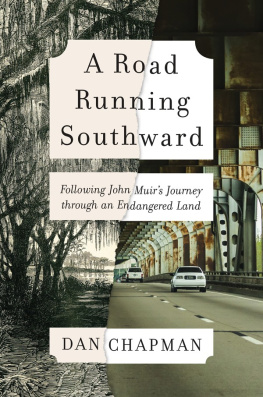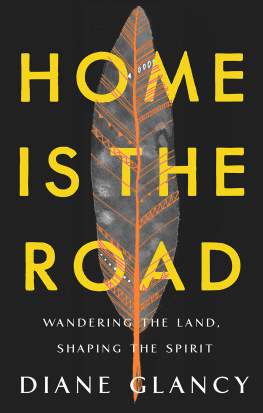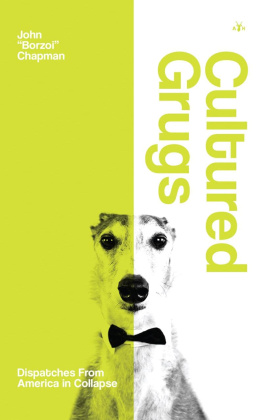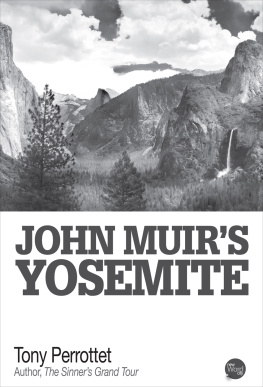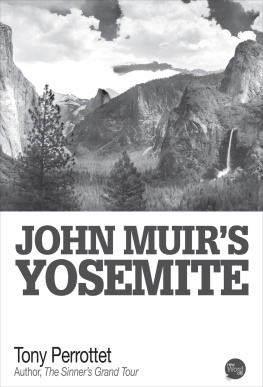Dan Chapman - A Road Running Southward: Following John Muirs Journey Through an Endangered Land
Here you can read online Dan Chapman - A Road Running Southward: Following John Muirs Journey Through an Endangered Land full text of the book (entire story) in english for free. Download pdf and epub, get meaning, cover and reviews about this ebook. year: 2022, publisher: Island Press, genre: Non-fiction. Description of the work, (preface) as well as reviews are available. Best literature library LitArk.com created for fans of good reading and offers a wide selection of genres:
Romance novel
Science fiction
Adventure
Detective
Science
History
Home and family
Prose
Art
Politics
Computer
Non-fiction
Religion
Business
Children
Humor
Choose a favorite category and find really read worthwhile books. Enjoy immersion in the world of imagination, feel the emotions of the characters or learn something new for yourself, make an fascinating discovery.
- Book:A Road Running Southward: Following John Muirs Journey Through an Endangered Land
- Author:
- Publisher:Island Press
- Genre:
- Year:2022
- Rating:5 / 5
- Favourites:Add to favourites
- Your mark:
- 100
- 1
- 2
- 3
- 4
- 5
A Road Running Southward: Following John Muirs Journey Through an Endangered Land: summary, description and annotation
We offer to read an annotation, description, summary or preface (depends on what the author of the book "A Road Running Southward: Following John Muirs Journey Through an Endangered Land" wrote himself). If you haven't found the necessary information about the book — write in the comments, we will try to find it.
Dan Chapman: author's other books
Who wrote A Road Running Southward: Following John Muirs Journey Through an Endangered Land? Find out the surname, the name of the author of the book and a list of all author's works by series.
A Road Running Southward: Following John Muirs Journey Through an Endangered Land — read online for free the complete book (whole text) full work
Below is the text of the book, divided by pages. System saving the place of the last page read, allows you to conveniently read the book "A Road Running Southward: Following John Muirs Journey Through an Endangered Land" online for free, without having to search again every time where you left off. Put a bookmark, and you can go to the page where you finished reading at any time.
Font size:
Interval:
Bookmark:

About Island Press
Since 1984, the nonprofit organization Island Press has been stimulating, shaping, and communicating ideas that are essential for solving environmental problems worldwide. With more than 1,000 titles in print and some 30 new releases each year, we are the nations leading publisher on environmental issues. We identify innovative thinkers and emerging trends in the environmental field. We work with world-renowned experts and authors to develop cross-disciplinary solutions to environmental challenges.
Island Press designs and executes educational campaigns, in conjunction with our authors, to communicate their critical messages in print, in person, and online using the latest technologies, innovative programs, and the media. Our goal is to reach targeted audiencesscientists, policy makers, environmental advocates, urban planners, the media, and concerned citizenswith information that can be used to create the framework for long-term ecological health and human well-being.
Island Press gratefully acknowledges major support from The Bobolink Foundation, Caldera Foundation, The Curtis and Edith Munson Foundation, The Forrest C. and Frances H. Lattner Foundation, The JPB Foundation, The Kresge Foundation, The Summit Charitable Foundation, Inc., and many other generous organizations and individuals.
The opinions expressed in this book are those of the author(s) and do not necessarily reflect the views of our supporters.

Island Presss mission is to provide the best ideas and information to those seeking to understand and protect the environment and create solutions to its complex problems. Click here to get our newsletter for the latest news on authors, events, and free book giveaways.
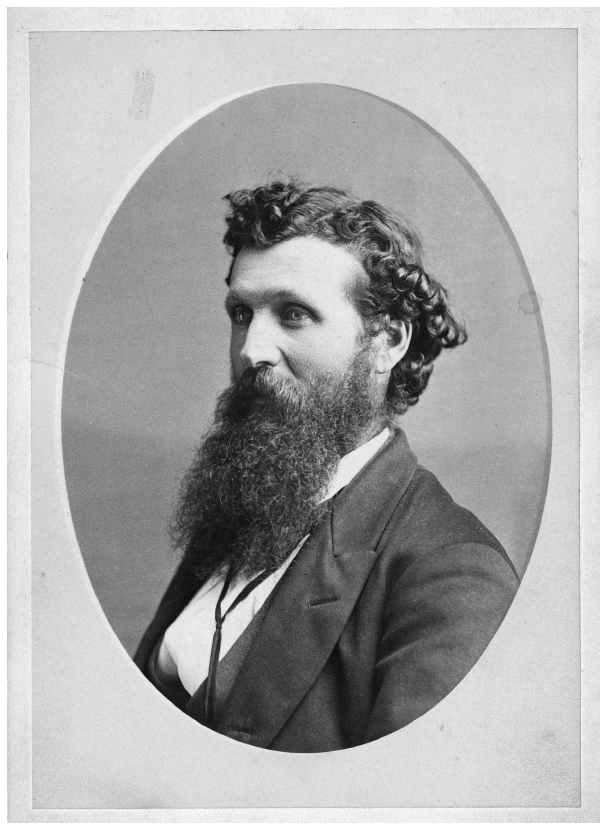
John Muir, circa 1870. Courtesy of the NPS, John Muir National Historic Site, JOMU 3519.
2022 Dan Chapman
All rights reserved under International and Pan-American Copyright Conventions. No part of this book may be reproduced in any form or by any means without permission in writing from the publisher: Island Press, 2000 M Street, NW, Suite 480-B, Washington, DC 20036-3319.
The findings and conclusions in this publication are those of the author and should not be construed to represent any official US Government determination or policy.
Library of Congress Control Number: 2021946477
All Island Press books are printed on environmentally responsible materials.
Manufactured in the United States of America
10 9 8 7 6 5 4 3 2 1
Keywords: John Muir, the South, walk, dispatches, endangered, Sierra Club, national park, botany, environment, sprawl, species, biodiversity, coal ash, mountains, Appalachian, climate change, Chattahoochee, natural resource, Savannah, sea level rise, invasive species, pollution, aquifer, Florida, development, wilderness
ISBN-13: 978-1-64283-195-5 (electronic)

Credit: Filippo Vanzo
I could not possibly have been placed in circumstances more highly favorable for study and exploration than those which I now enjoy. I am free from the distractions constantly arising in civilized life from social claims. Nature offers unceasingly the most novel and fascinating objects for learning.
Alexander von Humboldt
Savannah, Georgia By the time he reached this colonial city in the throes of Reconstruction, John Muir had walked more than seven hundred miles in thirty-eight days, guided by little more than divine inspiration, boundless curiosity, and a love of plants. Tired, hungry, and broke, he wandered the cobblestoned streets and the swampy outskirts of town in search of a place to sleep.
He ended up at Bonaventure Cemetery. It changed his life, and Americas relationship with nature.
Bonaventure was a private cemetery on the grounds of an old cotton plantation, a bucolic refuge along the Wilmington River with live oaks festooned in Spanish moss. The bluff afforded stunning views of the saltmarsh with cordgrass that magically changed colors as the day unfolded. Bald eagles, snowy white egrets, and monarch butterflies dotted the sky. It was mid-October and fall had yet to reach Savannah.
The rippling of living waters, the song of birds, the joyous confidence of flowers, the calm, undisturbable grandeur of the oaks, mark this place as one of the Lords most favored abodes of life and light, Muir wrote in A Thousand-Mile Walk to the Gulf.
He fashioned a small shelter of moss and sparkleberry bush and spent a half-dozen nights in Bonaventure. Each day he hiked three miles into town along a crushed shell road to the express office, where he hoped a package from his brother containing $150 awaited. He survived on breakfast crackers and water from a coffee-colored stream outside the cemeterys gate. Each day he grew fainter. Bonaventure, though, invigorated Muirs mind and made the twenty-nine-year-old wanderer reconsider long-held notions of life, death, nature, and mans twisted relationship with all three.
Why, he wondered, are humans considered more important than birds, bees, or bluets? Werent animals a sacred fabric of life and well-being, worthy of preservation and not to be killed for fashion, sport, or whim? The death of plants, animals, and men are all part of lifes natural cycle and Gods plan. Yet Muir intuited that nature would ultimately get crushed by man if not preserved. Flora and fauna of all sizes need spaceuntrammeled forests, mountain ranges, ocean preserves, wildlife refugesso their lives can proceed apace without undue human interference. Nature requires the smallest transmicroscopic creature that dwells beyond our conceitful eyes and knowledge, Muir wrote. Humans, too, need room to roam.
The budding environmentalist also began to realize at Bonaventure that there was more to life than collecting plants.
Never was Muir happier than outside the industrial grime and incessant clamor of the city. The Civil Wars destruction and ensuing decaythat he had witnessed while crossing Kentucky, Tennessee, North Carolina, and Georgia en route to Savannah and, ultimately, Florida solidified, for him, the preeminence of the natural world. Indeed, many of Bonaventures newer residentsgenerals, colonels, and privatesoffered silent testimony to mans capacity for awfulness. So-called civilization left a lot wanting; not so with nature, Muir believed.
Muirs environmental, ethical, and philosophical beliefs that under-gird the American conservation movement took hold at Bonaventure. Ironically, the father of the national parks, conscience of the environmental movement, cofounder of the Sierra Club, and passionate defender of all things wild owes much of his lifes work and reputation to the dead.
His transformational moment began with his experience at St. Bonaventure, a biographer wrote.
That was enough for me. It was time for a visit.
I leave Atlanta, my wife, Bita, and sons Sammy and Naveed on a warm October morning. It rains sporadically as my Subaru chugs south to Macon, then east to Savannah. My goal is to spend the night in Bonaventure as close to Muirs hidden spot in a dense thicket as possible. Id reported from Savannah a hundred times before and on occasion played tourist in the cemetery. The parklike layout is magnificent, with boulevards and paths bordered by towering oaks leading to the marsh, as is the craftsmanship of the tombs. Poet laureate Conrad Aikens gravesite includes a marble bench inscribed with the epitaph Cosmos Mariner Destination Unknown. The plot for songsmith Johnny Mercer (Moon River, Days of Wine and Roses) also includes a bench etched with his likeness. Little Gracie Watson, the cemeterys most beloved denizen, died at age six from pneumonia. Visitors leave toys and stuffed animals alongside the iron gate that surrounds her tomb and life-sized statue. Legend has it that tears of blood flow from Gracies eyes if her presents are removed.
Font size:
Interval:
Bookmark:
Similar books «A Road Running Southward: Following John Muirs Journey Through an Endangered Land»
Look at similar books to A Road Running Southward: Following John Muirs Journey Through an Endangered Land. We have selected literature similar in name and meaning in the hope of providing readers with more options to find new, interesting, not yet read works.
Discussion, reviews of the book A Road Running Southward: Following John Muirs Journey Through an Endangered Land and just readers' own opinions. Leave your comments, write what you think about the work, its meaning or the main characters. Specify what exactly you liked and what you didn't like, and why you think so.

